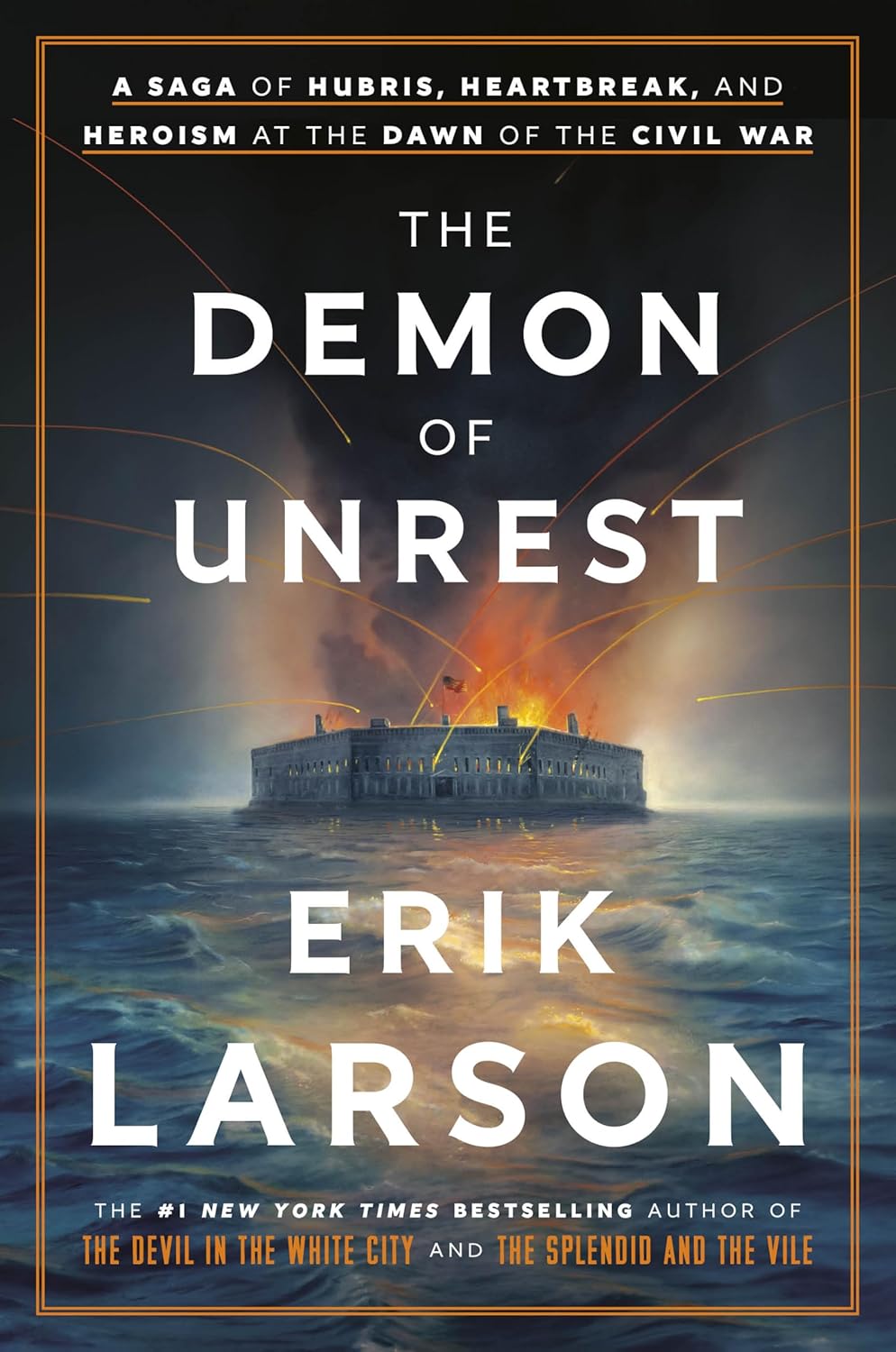The Demon of Unrest, A Saga of Hubris, Heartbreak and Heroism at the Dawn of the Civil War.





 I read a lot of books and usually find something to criticize in each so that I have never awarded a 5 Star rating until now. I believed it when I finished the book Thanksgiving Day 2024 and as I pick up my computer to address it I still feel the same way. Congratulations to Erik Larsen, his is a unique story telling talent in the mode of Shelby Foote with perhaps a touch more historical discipline.
I read a lot of books and usually find something to criticize in each so that I have never awarded a 5 Star rating until now. I believed it when I finished the book Thanksgiving Day 2024 and as I pick up my computer to address it I still feel the same way. Congratulations to Erik Larsen, his is a unique story telling talent in the mode of Shelby Foote with perhaps a touch more historical discipline.
Several years ago, I was given a book by my wife for Christmas The Splendid and the Vile” it was a story of Winston Churchill, his family and the impact of the “Blitz” on them at the start of WW 2. Like many books I set it aside on the “Read” shelf and there it sat. Last year, one of my wounded warriors and his wife sent me this book after having heard him speak down in North Carolina. They had him autograph a book and then sent it to me as a gift asking my opinion of it. Of course the open ended nature of the question and the gift moved this to the front of a very deep stack of books I intended to read over the next year. I often read three or four books simultaneously and one usually wins out and gets all my attention until its finished—such was the first chapter of The Demon that I read the Monday night of Thanksgiving week—it was done by Thanksgiving dinner—all 491 pages.
This is a narrative about the events and people involved in the firing on Fort Sumter on April 12th, 1861. Like many such narratives it starts with the tease entitled A Boat in the Night. Of course it is the description of the visit of the Confederate envoys to Sumter and their final demand for surrender or face a bombardment. The drama plays against the ultimatum and advise that war will commence in one hour’s time and the gaiety of society celebrating that evening before at the Charleston Battery where they would have ringside seats to the spectacular opening.
Larsen is a well established author who has had six previous historical best sellers and whose works have sold more than 12 million copies and are transcribed and published in 40 different countries. His deliberate style was described in his own foreword which he ties to the drama of January 6th, 2021. He noted that like so many of us as he watched the assault “unfold on camera, I had an Erie feeling that the present and past had merged.” He noted that these two great moments of national dread had both centered on the certification of the Electoral college vote and the transition of power. He admitted to being riveted and that “anxiety, anger and astonishment” he felt must have been similar to that experienced in 1860-1861 by Americans living in those days. He then pledged to organize and write the book to capture the long ago months in which the country lurched toward Civil War. He stated his hope (written in 2023) that the reader could step into the past trying not to project what you knew would happen—he said “I suspect your sense of dread will be all the more pronounced in light of today’s political discord….” In this he captures what I have always felt was the secret sauce to good history—that is connecting it to present experience for context and understanding the “Why?”does this matter question.
Larsen’s narrative is crisp, engaging and readable. I like to describe history writing as either Velcro or Page Turners. In the former the text is so turgid with factual material that is slows you to literally line by line and paragraph by paragraph. The page turner writes at a literate but less stilted vocabulary that lets your eyes dance across the page and dares you to not stop at the end of the chapter and indeed entices you to read on—its how you can finish a book in two or three days. This is a page turner!
A number of years ago, I found a book written by Maury Klein entitled Days of Defiance (Knopf 1997). I thought that was the finest book I had read on the coming of the war. It was supplemented by a book written by Russell McClintock entitled Lincoln and the Decision for War (The UNC Press 2008). This book is even better. The names: Chesnut, Lincoln, Ruffin, Anderson, Hammond and numerous others are familiar to most people. Organized in 7 parts, Larson sets the table in the context of southern society and its overarching code of honor.
The situation in South Carolina is outlined in “The Best of All Worlds” which discusses life in the south and South Carolina from 1807-1860. Each section opens with a quote from John Lyle Wilson’s The Code of Honor or Rules for the Government of Principals and Seconds in Dueling 1858.
Subsequent sections frame events from November 1860 to January 1861 “Treachery in the Wind”. “When you believe yourself aggrieved, be silent on the subject, speak to no one about the matter, and see your friend, who is to act for you as soon as possible.” The Code Duello; Precipice January 1-February 11; Journey February 11-March 4, 1861 “After all efforts for a reconciliation are over, the party aggrieved send a challenge to his adversary, which is delivered to his second”. the Code Duello; Coercion, March 4-29, 1861 “The Challengee has no option when negotiation has ceased, but to accept the challenge.” The Code Duello; Collision, March 29-April 9, 1861, “ We have been deeply wronged and if you are not disposed to repair the injury, the contest must continue…If…nothing by way of reparation (is offered) the fight continues until one or the other of the principals is hit.” The Code Duello and Fire: April 10-23, 1861. The Epilogue fast forwards to April 14, 1865 noting that “Can every insult be compromised? It is a mooted and vexed question. On this subject, no rules can be given that will be satisfactory.” The Code Duello.
Of course April 14th is the day Anderson raises the flag over Fort Sumter and Lincoln is assassinated. The last act is described in Edmund Ruffin’s diary June 18, 1865 “I here declare my unmitigated hatred for Yankee rule—to all political, social and business connections with Yankees and to the Yankee race…The end”. It was page 4099 of his 7 1/2 year diary. Within two hours unable to live in a restored Union, Edmund Ruffin, the unreconstructed rebel blows out his brains in Amelia County Virginia.
Larsen’s bonafides are excellent—a robust 12 page critical bibliography and more than 31 pages of end notes.
The style, manner of writing and narrative appeal to a widespread audience. As a final tribute, I immediately pulled out Larsen’s The Splendid and Vile. While not nearly as good, it also did not disappoint described in the New York Times Book Review as “Fresh, fast and deeply moving.” I agree. This is a book you will want to read and my thanks to Emily and Jessie Fletcher, two of America’s contemporary military heroes for the gift!
—Len Riedel
